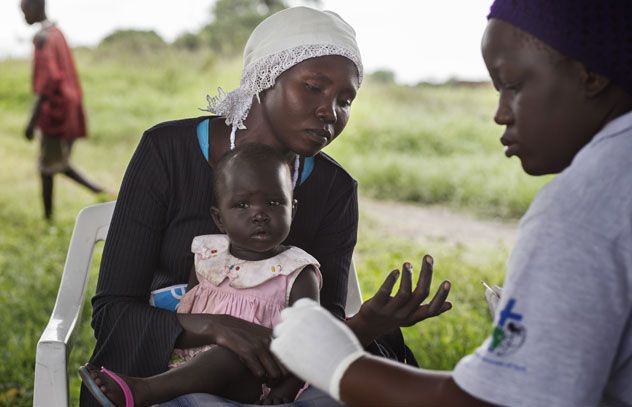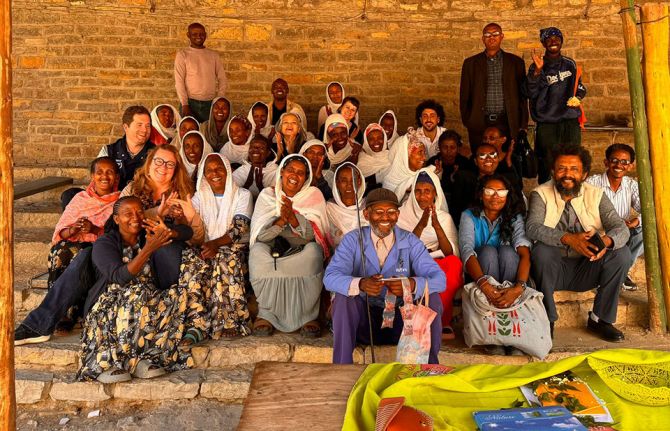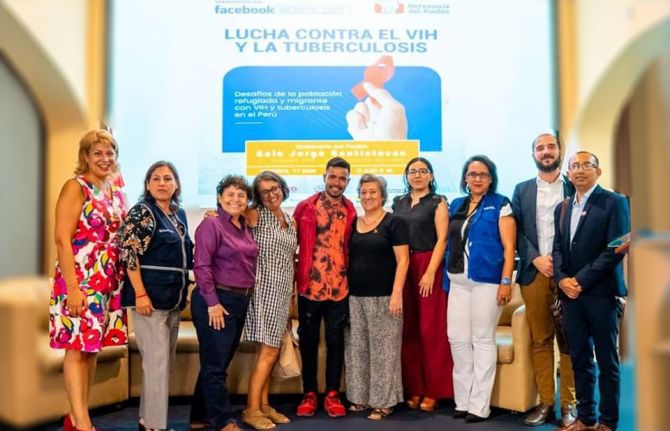

Feature Story
South Sudan: raising HIV awareness among displaced communities
08 September 2014
08 September 2014 08 September 2014Anywur Mayan took her first HIV test two years ago. A health worker came to her house in rural Jonglei State and briefly explained that he was checking her for a virus. He pricked her finger and drew some blood. A few minutes later he told her the test had come back negative and left.
She did not really learn what HIV is or how it is spread until early June this year, after she had moved hundreds of miles from her Jonglei home to escape fighting there. Her new settlement Nimule—a border town near South Sudan’s border with Uganda—is safer, but has much higher HIV prevalence.
Behind there, there is nothing,” said Anywur, pointing in the direction of Jonglei. “Our houses, our belongings, they were all destroyed.
Fighting broke out in the South Sudanese capital, Juba, in mid-December and spread rapidly across nearly half the country. The United Nations Office for the Coordination of Humanitarian Affairs estimates that tens of thousands of people have been killed and more than 1.7 million have fled from their homes since December 2013—about 1.3 million displaced internally and 448 000 seeking refuge in neighbouring countries.
Raising awareness
Anywur, with her husband and infant son, set out in January for Nimule, where the HIV prevalence—estimated at 4.4%, according to the 2012 Antenatal Clinics Surveillance Report—is well above the national average of 2.6%.
In Anywur’s new home in Nimule a collection of local organizations has taken on the task of raising awareness about HIV. Anywur said she only found out what HIV is when a team of community educators gave a detailed presentation about the virus with the aid of information, education and communication materials created by the South Sudan AIDS Commission (SSAC) and UNAIDS.
Where we came from, this kind of education, it is not there,” she said.
But local activists and health workers said they still have thousands more people they need to reach and not enough resources to do it. At the same time, the new arrivals add a layer of complexity to the work they were already doing in the community.
HIV services
The highway connecting Juba to Uganda and the rest of eastern Africa cuts through Nimule, which hosts the country’s most active border crossing. Overloaded trucks rumble through the town at all hours, carrying fruits and vegetables, mattresses and anything else that can be sold in Juba’s markets.
Like many border towns, Nimule has its share of sex workers and their clients, especially long-distance truck drivers. The 2013 South Sudan Global AIDS Response Progress Report estimates that 62.5% of all new adult HIV infections in the country last year arose from sex work, the majority being clients of female sex workers.
Before the fighting broke out, Patrick Zema, Nimule Hospital’s HIV testing and counselling supervisor, said they were making significant progress in increasing awareness about the virus, reducing stigma and linking people to services. The hospital currently has 1 300 clients enrolled in antiretroviral therapy.
But now they are starting from the beginning with the displaced communities. “They come and they fear to test their blood,” said Pascalina Idreangwa Enerko, the chairperson of the local Cece Support Group of People Living with HIV, who attributes this behaviour to a combination of a lack of knowledge about the virus and stigma that comes with an HIV-positive diagnosis. “Thanks to the health education provided, they come out. It is important that they know their status.
Since April, Cece has teamed up with two community-based organizations—Humans Must Access Essentials (HUMAES) and Caritas Torit—to do near-daily mobile awareness-raising campaigns within the far-flung displaced community.
The community mobilizers begin with an hour-long presentation on HIV awareness and prevention. Then they encourage people to visit different stations, including one for paediatric consultations, a free drug dispensary and an HIV testing centre.
Reena’e Awuor Ondiek, Caritas Torit’s HIV counsellor, said her table was not popular when they first started in February, but she has noticed a change in people’s attitudes as she has made repeated visits to the same communities.
The programme has also helped address one of the other major challenges created by the crisis. “The conflict moved people from one place to another and interrupted follow up,” said Habib Daffalla Awongo, SSAC’s director general for programme coordination. “Some patients have been lost within host populations.” During their community visits, a Caritas team has already located people who stopped treatment as they fled the fighting and restarted them on antiretroviral therapy.
The team is still facing challenges, the most critical being a shortage of money. They are unable to hire the vehicles they need to reach thousands of displaced people who are camping outside of Nimule and who have almost no access to HIV services.
But Ondiek said there is no shortage of people like Anywur who need their services in the communities they can reach.



